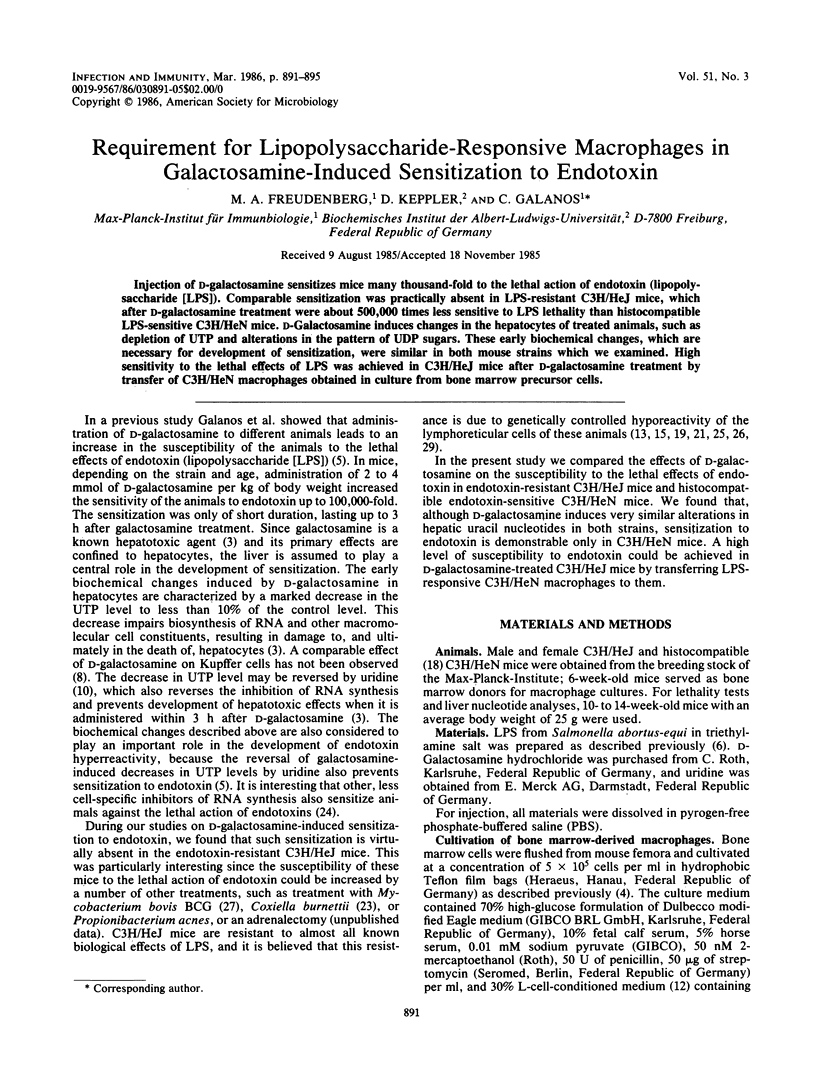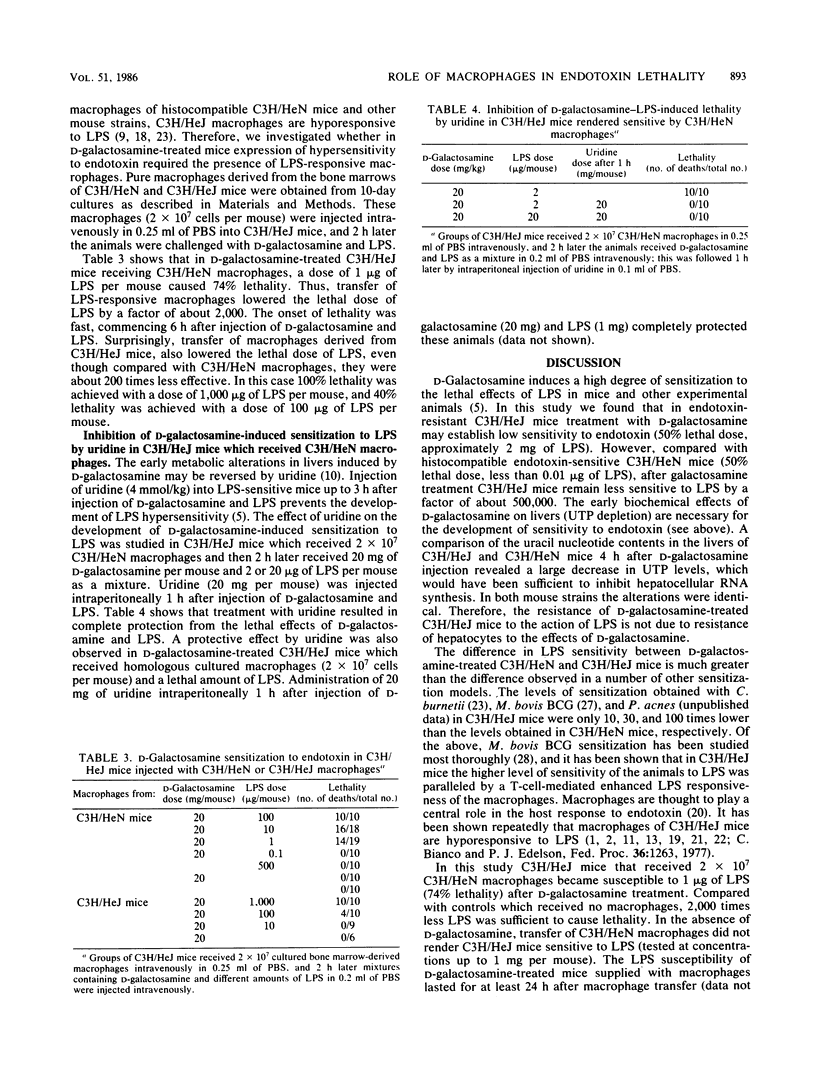Abstract
Injection of D-galactosamine sensitizes mice many thousand-fold to the lethal action of endotoxin (lipopolysaccharide [LPS]). Comparable sensitization was practically absent in LPS-resistant C3H/HeJ mice, which after D-galactosamine treatment were about 500,000 times less sensitive to LPS lethality than histocompatible LPS-sensitive C3H/HeN mice. D-Galactosamine induces changes in the hepatocytes of treated animals, such as depletion of UTP and alterations in the pattern of UDP sugars. These early biochemical changes, which are necessary for development of sensitization, were similar in both mouse strains which we examined. High sensitivity to the lethal effects of LPS was achieved in C3H/HeJ mice after D-galactosamine treatment by transfer of C3H/HeN macrophages obtained in culture from bone marrow precursor cells.
Full text
PDF




Selected References
These references are in PubMed. This may not be the complete list of references from this article.
- Agarwal M. K., Lazar G. Biological reactions to bacterial endotoxins in the non-responder C3H/HeJ mouse strain. Microbios. 1984;39(157-158):193–207. [PubMed] [Google Scholar]
- Chedid L., Parant M., Damais C., Parant F., Juy D., Galelli A. Failure of endotoxin to increase nonspecific resistance to infection of lipopolysaccharide low-responder mice. Infect Immun. 1976 Mar;13(3):722–727. doi: 10.1128/iai.13.3.722-727.1976. [DOI] [PMC free article] [PubMed] [Google Scholar]
- Decker K., Keppler D. Galactosamine hepatitis: key role of the nucleotide deficiency period in the pathogenesis of cell injury and cell death. Rev Physiol Biochem Pharmacol. 1974;(71):77–106. doi: 10.1007/BFb0027661. [DOI] [PubMed] [Google Scholar]
- Flesch I., Ecker B., Ferber E. Acyltransferase-catalyzed cleavage of arachidonic acid from phospholipids and transfer to lysophosphatides in macrophages derived from bone marrow. Comparison of different donor- and acceptor substrate combinations. Eur J Biochem. 1984 Mar 15;139(3):431–437. doi: 10.1111/j.1432-1033.1984.tb08023.x. [DOI] [PubMed] [Google Scholar]
- Galanos C., Freudenberg M. A., Reutter W. Galactosamine-induced sensitization to the lethal effects of endotoxin. Proc Natl Acad Sci U S A. 1979 Nov;76(11):5939–5943. doi: 10.1073/pnas.76.11.5939. [DOI] [PMC free article] [PubMed] [Google Scholar]
- Galanos C., Lüderitz O., Westphal O. Preparation and properties of a standardized lipopolysaccharide from salmonella abortus equi (Novo-Pyrexal). Zentralbl Bakteriol Orig A. 1979 Apr;243(2-3):226–244. [PubMed] [Google Scholar]
- Goud T. J., Schotte C., van Furth R. Identification and characterization of the monoblast in mononuclear phagocyte colonies grown in vitro. J Exp Med. 1975 Nov 1;142(5):1180–1199. doi: 10.1084/jem.142.5.1180. [DOI] [PMC free article] [PubMed] [Google Scholar]
- Hofmann F., Wagle S. R., Decker K. Effect of d-galactosamine administration on nucleotide and protein metabolism in isolated rat Kupffer cells. Hoppe Seylers Z Physiol Chem. 1976 Dec;357(10):1395–1400. doi: 10.1515/bchm2.1976.357.2.1395. [DOI] [PubMed] [Google Scholar]
- Holstege A., Schulz-Holstege C., Henninger H., Reiffen K. A., Schneider F., Keppler D. O. Uridylate trapping induced by the C-2-modified D-glucose analogs glucosone, fluoroglucose, and glucosamine. Eur J Biochem. 1982 Jan;121(2):469–474. doi: 10.1111/j.1432-1033.1982.tb05811.x. [DOI] [PubMed] [Google Scholar]
- Keppler D. O., Pausch J., Decker K. Selective uridine triphosphate deficiency induced by D-galactosamine in liver and reversed by pyrimidine nucleotide precursors. Effect on ribonucleic acid synthesis. J Biol Chem. 1974 Jan 10;249(1):211–216. [PubMed] [Google Scholar]
- Michalek S. M., Moore R. N., McGhee J. R., Rosenstreich D. L., Mergenhagen S. E. The primary role of lymphoreticular cells in the mediation of host responses to bacterial endotoxim. J Infect Dis. 1980 Jan;141(1):55–63. doi: 10.1093/infdis/141.1.55. [DOI] [PubMed] [Google Scholar]
- Morrison D. C., Ulevitch R. J. The effects of bacterial endotoxins on host mediation systems. A review. Am J Pathol. 1978 Nov;93(2):526–618. [PMC free article] [PubMed] [Google Scholar]
- Neumann C., Sorg C. Sequential expression of functions during macrophage differentiation in murine bone marrow liquid cultures. Eur J Immunol. 1980 Nov;10(11):834–840. doi: 10.1002/eji.1830101107. [DOI] [PubMed] [Google Scholar]
- Rosenstreich D. L., Glode L. M. Difference in B cell mitogen responsiveness between closely related strains of mice. J Immunol. 1975 Sep;115(3):777–780. [PubMed] [Google Scholar]
- Ruco L. P., Meltzer M. S. Defective tumoricidal capacity of macrophages from C3H/HeJ mice. J Immunol. 1978 Jan;120(1):329–334. [PubMed] [Google Scholar]
- Ruco L. P., Meltzer M. S. Macrophage activation for tumor cytotoxicity: tumoricidal activity by macrophages from C3H/HeJ mice requires at least two activation stimuli. Cell Immunol. 1978 Nov;41(1):35–51. doi: 10.1016/s0008-8749(78)80026-4. [DOI] [PubMed] [Google Scholar]
- Schramek S., Kazar J., Sekeyova Z., Freudenberg M. A., Galanos C. Induction of hyperreactivity to endotoxin in mice by Coxiella burnetii. Infect Immun. 1984 Sep;45(3):713–717. doi: 10.1128/iai.45.3.713-717.1984. [DOI] [PMC free article] [PubMed] [Google Scholar]
- Seyberth H. W., Schmidt-Gayk H., Hackenthal E. Toxicity, clearance and distribution of endotoxin in mice as influenced by actinomycin D, cycloheximide, -amanitin and lead acetate. Toxicon. 1972 Aug;10(5):491–500. doi: 10.1016/0041-0101(72)90175-4. [DOI] [PubMed] [Google Scholar]
- Sultzer B. M. Genetic control of leucocyte responses to endotoxin. Nature. 1968 Sep 21;219(5160):1253–1254. doi: 10.1038/2191253a0. [DOI] [PubMed] [Google Scholar]
- Vogel S. N., Moore R. N., Sipe J. D., Rosenstreich D. L. BCG-induced enhancement of endotoxin sensitivity in C3H/HeJ mice. I. In vivo studies. J Immunol. 1980 Apr;124(4):2004–2009. [PubMed] [Google Scholar]
- Vogel S. N., Weedon L. L., Wahl L. M., Rosenstreich D. L. BCG-induced enhancement of endotoxin sensitivity in C3H/HeJ mice. II. T cell modulation of macrophage sensitivity to LPS in vitro. Immunobiology. 1982 Feb;160(5):479–493. doi: 10.1016/S0171-2985(82)80010-7. [DOI] [PubMed] [Google Scholar]
- Weinberg J. B., Chapman H. A., Jr, Hibbs J. B., Jr Characterization of the effects of endotoxin on macrophage tumor cell killing. J Immunol. 1978 Jul;121(1):72–80. [PubMed] [Google Scholar]


